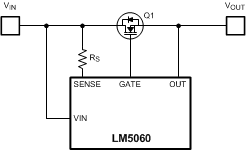SNVS628H October 2009 – December 2019 LM5060
PRODUCTION DATA.
- 1 Features
- 2 Applications
- 3 Description
- 4 Revision History
- 5 Pin Configuration and Functions
- 6 Specifications
- 7 Detailed Description
-
8 Application and Implementation
- 8.1 Application Information
- 8.2
Typical Applications
- 8.2.1
Example Number 1: LM5060EVAL Design
- 8.2.1.1 Design Requirements
- 8.2.1.2
Detailed Design Procedure
- 8.2.1.2.1 VDS Fault Detection and Selecting Sense Pin Resistor RS
- 8.2.1.2.2 Turn-On Time
- 8.2.1.2.3 Fault Detection Delay Time
- 8.2.1.2.4 MOSFET Selection
- 8.2.1.2.5 Input and Output Capacitors
- 8.2.1.2.6 UVLO, OVP
- 8.2.1.2.7 POWER GOOD Indicator
- 8.2.1.2.8 Input Bypass Capacitor
- 8.2.1.2.9 Large Load Capacitance
- 8.2.1.3 Application Curves
- 8.2.2 Example Number 2: Reverse Polarity Protection With Diodes
- 8.2.3 Example Number 3: Reverse Polarity Protection With Resistor
- 8.2.1
Example Number 1: LM5060EVAL Design
- 9 Power Supply Recommendations
- 10Layout
- 11Device and Documentation Support
- 12Mechanical, Packaging, and Orderable Information
8.2.1.2.1 VDS Fault Detection and Selecting Sense Pin Resistor RS
The LM5060 monitors the VDS voltage of the external N-Channel MOSFET. The drain to source voltage threshold (VDSTH), which is set with the resistor RS, is shown in Figure 27;
Equation 1. VDSTH = (RS x ISENSE) - VOFFSET
The MOSFET drain to source current threshold is:
Equation 2. 

where
- RDS(ON) is the resistive drop of the pass element Q1 in Figure 27
- VOFFSET is the offset voltage of the VDS comparator
- ISENSE (16 µA typical) is the threshold programming current
 Figure 27. Setting the VDS Threshold
Figure 27. Setting the VDS Threshold